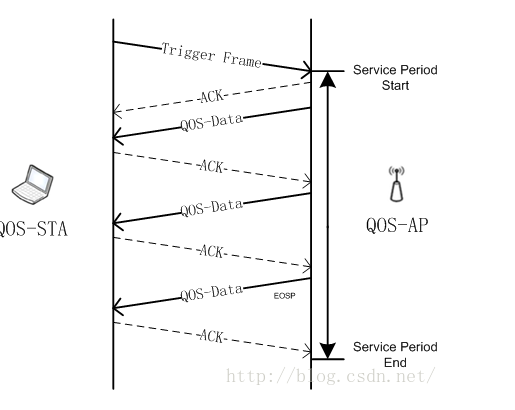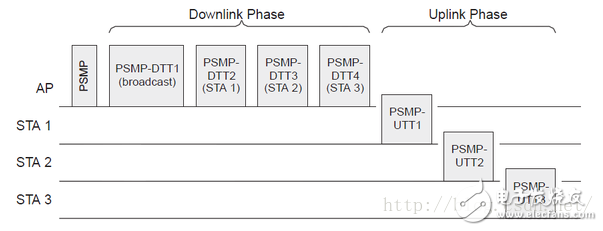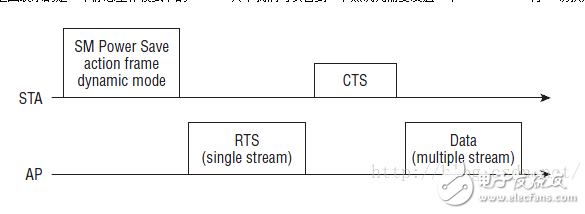In this article, we will explore four energy-saving modes defined under the 802.11 protocol: PSM, APSD, PSMP, and SMPS. Among these, APSD is specifically designed based on the 802.11e standard. In APSD, the node operates in a way that first divides the uplink and downlink transmission processes. U-APSD, a variant of APSD, can only be used within the EDCA mode.
The original version of 802.11 introduced four energy-saving mechanisms, with PSM being the most fundamental. Designed to ensure stable operation, PSM uses a conservative approach. However, later versions of the standard aimed to enhance performance by introducing additional power-saving options. This article focuses on three key energy-saving modes: APSD, PSMP, and SMPS.
APSD (Automatic Power Save Delivery) is an enhancement over the basic PSM mode. The main issue with PSM is its "ping-pong" mechanism when requesting data—alternating between polling frames and data frames. This can lead to inefficiency, especially when there's a large amount of buffered data. To address this, APSD was introduced.
Based on 802.11e, APSD introduces the concept of a Service Period (SP), during which a node can transmit multiple frames without repeated polling. There are two working modes in APSD: S-APSD and U-APSD. While this article won't go into detailed explanations of SP or EDCA, they are essential for understanding how APSD functions.
The diagram below illustrates the basic idea of APSD:

In the example, a QoS-AP communicates with a QoS-STA. When the QoS-STA initiates a transmission, it sends a "Trigger Frame," such as a QoS Data or QoS Null frame. This triggers a Service Period, allowing the AP to send multiple frames in sequence. Once the AP has finished transmitting, it marks the last frame with an EOSP (End of Service Period), signaling the end of the service time.
Compared to the traditional PS-Poll mechanism, where one request leads to one response, APSD allows multiple frames to be exchanged in a single request, significantly improving efficiency.
S-APSD (Scheduled APSD) operates in both EDCA and HCCA modes. It is more like an extension of the earlier PSM-PCF mode. The service period is pre-scheduled via the Schedule Element field in a management frame, so the node knows exactly when to wake up. In the diagram below, the QoS-AP sends a PS-Poll trigger, and the QoS-STA wakes up to exchange data until the service period ends.

U-APSD (Unscheduled APSD), on the other hand, works in EDCA mode only. Unlike S-APSD, which is initiated by the AP, U-APSD is triggered by the node itself. The node sends a trigger frame (such as a QoS-Null) to start a service period. Then, the AP and node exchange data in a back-and-forth manner.

While both S-APSD and U-APSD use service periods, the scheduling mechanism differs. S-APSD relies on pre-scheduled timing, while U-APSD allows nodes to initiate service periods at any time.
Next, we look at PSMP (Power-Save Multi-Poll), introduced in 802.11n. This mode enhances energy savings by using a stricter scheduling mechanism. It divides the transmission cycle into two parts: PSMP Downlink Transmission Time (PSMP-DTT) and PSMP Uplink Transmission Time (PSMP-UTT).
During PSMP-DTT, the AP sends data in bursts, often using RIFS (Reduced Interframe Spacing) instead of SIFS. This allows the node to wake up directly during scheduled times, reducing listening overhead. During PSMP-UTT, the node only wakes up to send uplink data, further saving energy.

Finally, we discuss SMPS (Spatial Multiplexing Power Save), introduced in 802.11n. In this mode, a node can turn off extra antennas to save power. However, since the AP may transmit using multiple spatial streams, the node must stay ready to receive. SMPS allows the node to switch between single and multi-stream modes depending on the situation.
There are two types of SMPS: Static and Dynamic. In static mode, the node sends an action frame to request a single-stream transmission from the AP. To return to multi-stream mode, another action frame is needed. In dynamic mode, the AP automatically switches to single-stream mode for the next frame after receiving a dynamic mode action frame, then returns to multi-stream mode afterward.


These energy-saving modes play a crucial role in optimizing power consumption in wireless networks, especially for battery-powered devices. Understanding them helps in designing more efficient and sustainable wireless communication systems.
3.2V Lifepo4 Battery, 3.2V lithium ion battery, Lifepo4 Battery cell
Foshan Keylewatt Technology Co., LTD , https://www.klwenergy.com